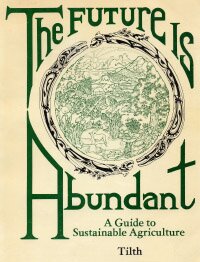
The Future is Abundant
A Guide to Sustainable Agriculture
Tilth Producers of Washington Home | WA Tilth Assoc. | Conference | Directory | Journal | Placement Service | Calendar | Action Alerts
Legislative Update | Bulletin Board | Classifieds | Questions on Agriculture? | Photo Gallery | Links | Contact Us | Join Now | Volunteer

The words Pacific Northwest bring visions of rainy skies and dense rainforests, but is is equally correct to imagine dry, sagebrush landscapes, extensive irrigation systems, dryland farming and juniper savannas. In fact, as the accompanying map illustrates, nearly half of the region is arid, receiving less than 20 inches of annual precipitation.
Desertification is of increasing concern around the world, and its symptoms are becoming evident even in the Northwest. In Desertification of the United States, David Sheridan lists the following symptoms of desertification -- declining ground water tables, salinization of topsoil and water, reduction of surface waters, unnaturally high soil erosion, and the destruction of native vegetation. "An arid area suffering from desertification can manifest all five symptoms," he notes, "but the existence of any one can mean that it is undergoing desertification." In essence, desertification means a loss of the land's capacity to support life, and by that criterion large areas of the Northwest are threatened with spreading deserts.
Rising energy costs, severe soil erosion, and increased competition for water from the Columbia and Snake Rivers threaten the future of large-scale irrigation projects. Yet with proper husbandry, the arid lands of the Interior have the potential to support sustainable communities. In his article entitled "Runoff Farming for Dry Lands" (The New Farm, May/ June 1981), Gary Nabhan describes some ancient desert farming techniques which may prove useful to dryland farmers today.
As Gary notes, the major water supply in arid and semi-arid areas is storm runoff. Many sophisticated systems have been developed for utilizing this water. Most have three parts: the catchment area, the storage area, and the planting area. A catchment can be a large, natural watershed or a smaller area treated or compacted to increase runoff. Storage areas can range from ponds or tanks to the soil of the area to be planted.
Macro- and micro-catchments are both practical possibilities for dryland agriculturalists. A micro-catchment may be an area compacted uphill of a single plant, such as a shrub. Surrounded by a berm, the catchment funnels water toward a basin around the shrub. A macro-catchment enlarges upon this basic technique (see above).
Gary concludes, "Systems differ in cost, size and efficiency, but...all are within the means of small farmers in the West who have basic tillage implements...Runoff farming, an ancient technique in arid lands, is bound to play an important role again for future desert dwellers."
Tilth Producers of Washington Home | WA Tilth Assoc. | Conference | Directory | Journal | Placement Service | Calendar | Action Alerts
Legislative Update | Bulletin Board | Classifieds | Questions on Agriculture? | Photo Gallery | Links | Contact Us | Join Now | Volunteer